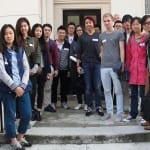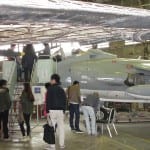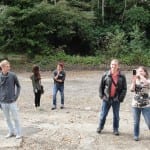New Start for Technology Management
By Matt Whyndham, on 7 November 2014
The MSc in Technology Management, recently introduced at UCL by the Technology Management Group at the Department of Space and Climate Physics, accepted its first intake in September. Matt Whyndham, the Programme Tutor, reflects on the start of the programme.
The last couple of months witnessed a concerted campaign of activity in TMG, as the new academic year got started with increased enrolments. This year, we are starting a new track in our academic programme: MSc Technology Management. Over the summer period, we had received a good number of applications for this new degree, and 15 new students eventually enrolled in September.
These photos show new students enjoying an outing the the Brooklands Museum during the first week of Term.
______
The Technology Management programme is closely related to MSc Systems Engineering Management, which is continuing alongside. Its initial core module is Technology Strategy, which looks at the way technology-based products, being pervasive in modern society, are conceived, developed and acquired. It covers engineering, organisation, project and programme management and a variety of other interdisciplinary topics.
We’re really excited about this new teaching track, not only because of the opportunity to reach more students, but also because we can teach within a bigger range of topics that link to our research fields. So, we are looking forward to sharing current research with our students, as well as encouraging them to start creating research themes of their own. OK, so we will have more dissertations to read in July and August, but this is regarded as a perk of the job!
Our modular programme (which fits with industry-based learning) is something that younger graduates are not always used to. The week-long blocks are quite intense at first, but in between those weeks, they are quickly learning that there’s no such thing as “free” time. There’s always some independent reading on the agenda, consultation with tutors, or preparation of an assignment to be done.
Also, in London, they are continually confronted by inspiring evidence of technology development of the past and present. UCL’s home district of Bloomsbury, once a series of quiet fields, and despite its relaxed, perhaps even blithe, academic atmosphere, is now firmly linked to the pulse of the modern capital, with the central district a few minutes walk away, and three major railway stations just over or along the Euston Road.
On reflection, this area has been in the current of technology development for some time. Here’s a fascinating extract from: Pandaemonium: the Coming of the Machines as seen by Contemporary Observers 1660 – 1886, by Humphrey Jennings. Readers might recall some of the flavour of this in the Olympic Games opening ceremony in London 2012 (indeed, it was one of the major sources for the artistic team). This little vignette, or case study, captures just the sort of concerns we discuss in the course: the invention of new devices, products and services, their integration with what’s already there, and the fascination and magic that results when it all goes right.
Euston Station connects London with Birmingham, Manchester and further destinations, and a station has stood there since 1837.
The Euston Station November 1848
From an article in the Quarterly Review, December 1848, by Sir Francis Head.
In a clear winter’s night the arrival of an up-train at the platform before us forms a very interesting picture.
No sound is heard in the cold air but the hissing of the pilot engine, which, like a restless spirit advancing and retrograding, is stealing along the intermediate rails, waiting to carry off the next down train; its course being marked by white steam meandering above it and by red-hot coals of different sizes which are continually falling from beneath it. In the obscure scene, the Company’s interminable lines of gas lights (there are 232 at the Euston Station) economically screwed down to the minimum of existence, feebly illuminating the damp varnished panels of the line of carriages in waiting, the brass doorhandles of the cabs, the shining hames, brass brow bands and other ornaments on the drooping heads and motionless backs of the cab-horses; and while the blood red signal lamp is glaring near the tunnel to detail on unauthorised intrusion, the stars of heaven cast a faint silvery light through the long strips of plateglass in the roof above the platforms. On a sudden is heard – the stranger hardly knows whence – the mysterious moan of compressed air, followed by the ringing of a bell. That instant every gaslight on and above the curve of 900 feet bursts into full power. The carriages, cabs, &c. appear, comparatively speaking, in broad daylight, and the beautiful iron reticulation which sustains the glazed roof appears like fairy work.
 Close
Close










